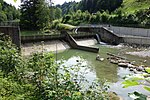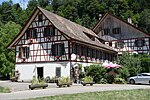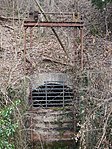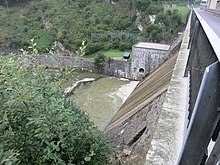Run-of-river power plants on the Sihl
The run-of-river power plants on the Sihl used the water of the Sihl in the Sihl valley from the Sihlsee ( 889 m above sea level ) around 40 kilometers downstream to the confluence ( 402 m above sea level ) with the Limmat in the city of Zurich .
History of hydropower in the Sihl valley (downstream)
- Einsiedeln
From 1932 to 1937, a dam and two dams were built in the Einsiedeln high valley in order to dam the Sihl into a reservoir, the largest in Switzerland in terms of area. The gradient between the Sihlsee and the Etzelwerk in Altendorf SZ on Lake Zurich is used to generate traction current for the Swiss Federal Railways , which owns the plant. The pumped storage plant can pump water from Lake Zurich to Lake Sihl.
- Schindellegi-Feusisberg
In 1983, Kraftwerk Feusisberg AG was granted water rights until 2038 to use the stretch of water from the Geissboden measuring weir ( 782 m above sea level ) until the turbinated water was returned to EW Schindellegi ( 751 m above sea level ).
In Schindellegi , the wood was processed in two sawmills. The first saw was built at the site of today's saw in 1562. In 1895, a Francis turbine was installed in place of the water wheel, which started generating electrical energy in 1918. A new Francis turbine with an output of 100 kW was in operation from 1939 to 1986.
In 1869 a cotton weaving mill JC Zwicky & Cie was built on the Sihl in Schindellegi, which was operated with water power. The old saw that is still in working order is looked after and maintained by the Schindellegi Sagiverein.
EW Höfe AG's Feusisberg (KWF) power plant was commissioned in 1989 at the Schindellegi site. The run-off power plant is operated by Kraftwerk Feusisberg AG. The water collected in the reservoir is transported through a tunnel to the machine house. The 21 meter pressure gradient, which builds up the power required for the 0.6 megawatt turbine, begins in the moat. An average of 4.65 GW of electricity is produced annually. The outlet of the turbined water ends in the backwater of the Sihl-Höfe power plant (KSH).
On the border between the cantons of Schwyz and Zurich, the Sihl-Höfe (KSH) power plant was commissioned by EW Höfe AG in 1961. It is a run-off power plant in which the water is collected in a reservoir and transported to the machine house via a tunnel. The KSH takes over the regulation of the residual water quantity (doping water quantity ) for Etzelwerk AG . The average annual net energy production is 8.5 GW, the amount of water 4.2 m³ / s.
- Huts
The Hütten weir system was built from 1894 to 1895 by AG Elektrizitätswerk an der Sihl near Hütten ZH and was renewed, automated and remote-controlled from 1965 to 1966. The weir guides the Sihl water from the Hütten facility ( 685 m above sea level ) through a 2.2 km long tunnel into the Teufenbachweiher ( 681 m above sea level ).
- Schönenberg
The Teufenbachweiher in Schönenberg ZH is a reservoir built in 1895 for the Waldhalde power plant. The water is led from the pond through a pressure pipe with a height difference of 72 meters to the turbine house in the Waldhalde on the Sihl.
The Waldhalde power plant was the first power plant of the electricity works of the canton of Zurich (EKZ) to be built between 1893 and 1895 by the AG Elektrizitätswerke an der Sihl. The Sihl water from the Teufenbachweiher was turbinated by five Girard turbines with 400 HP each. In 1908 the work was transferred to the newly founded EKZ. In 1915 and 1940 the old machine groups were replaced with Francis turbines (three-phase alternators with 50 Hz). In 1966 a new machine house was built, which was equipped with a 3670 HP Francis turbine and an automatic three-phase generator. The last renovation took place in 2009 in order to be able to operate the power plant until the concession expired in 2047. The turbined water is fed into the Sihl immediately after the nacelle.
- Sihlbrugg
The factory in Schiffli was founded in the 19th century on the Sihl in Sihlbrugg. It used the water power of the Sihl and produced looms for looms. In 1988 the factory was converted into a commercial center. The Sihl water is used as a driving force for the in-house electricity production.
- Horgen
The abundance of forests in the Sihl valley led to the establishment of numerous water-powered sawmills on the banks of the Sihl. The city of Zurich's own urban forest in the Sihlwald in the municipality of Horgen has served the city of Zurich as the most important supplier of construction timber and firewood since the Middle Ages. In 1864 the city built a factory with around 100 employees, residential buildings, a school and a post office. A hydropower plant operated with Sihl water served for the sawmill and the factory (water law no. 46 1862-1976). The wood was loosened on the Sihl as far as Zurich. The construction of Sihlstrasse in 1856 led to the end of rafting in 1866.
In the middle of the 19th century, the water power of the rivers was used after the side streams. With the factory canal, a continuous, now mostly filled, hydropower axis was created in the Sihlwald from the Sihlwald to the city of Zurich: Sihlwald sawmill, Gattikerweiher pumped storage plant and Schmid Gattikon canal, Langnau spinning mill, Adliswil mechanical silk weaving mill, cotton mill in the village of Adliswil, Sood cotton mill, Sood spinning mill, Manegg spinning mill Paper factory on the Sihl.
- Gattikon
The Gattikon mill was operated around 1460 by Hans Müller, from 1570 by the Schwarzenbach family and from 1780 by Hans Heinrich Schmid (1727–1792) and heirs. In 1815 Hans Jakob Schmid-Beerli (1796–1839) founded the old mechanical cotton spinning mill above his mill in Gattikon, which was liquidated in 1892.
The new mechanical cotton spinning and weaving mill Schmid was set up in 1859 by Heinrich Schmid in Gattikon below the mill and spinning axis Chrebsbach on the banks of the Sihl. There the father and mill owner Hans Jakob Schmid acquired the right to use the Sihl water from the canton of Zurich in 1833.
Energy was supplied through a 1.5 kilometer long Sihl water canal and, from 1863, a second pond (front Gattikerweiher or Waldweiher) and the Geissau pumped storage plant (Gattikon) including a moated castle. When it was dry, the water from the Sihl was pumped up into the Gattikerweiher in order to be able to supply the mill and spinning mills of Gattikon with sufficient water power. It is one of the oldest pumped storage plants in the world. The factory had a steam engine (steam boiler house with high chimney) and its own gas works for lighting.
- Adliswil
The mechanical silk weaving mill in Adliswil (MSA) on the Sihl (Adliswil, Sihlau) was founded in 1863. At times it had over 1,000 employees. She turned the farming settlement into an industrial village. In 1889 the MSA procured a mobile steam engine ( locomobile ) for energy production at low water. The global economic crisis of the 1920s led to the gradual reduction of production and jobs. At the end of 1934, production had to be stopped and the buildings had to be rented to entrepreneurs. MSA was self-sufficient in terms of gas lighting and it produced its electrical energy itself until 1975.
The Nägeli mill in Adliswil was first mentioned in 1248 and was owned by the Nägeli von Kilchberg family for centuries . It was demolished in 1965 for the construction of the main road.
The cotton spinning mill in the village was founded in Adliswil in 1823 by the Schoch brothers in Oberdorf below the mill on the Sihl (cotton spinning and weaving mill from Staub, Landis & Cie.). In 1850 it was taken over by Heinrich Schmid, Gattikon. He was co-founder (1850) and president (1850–1873) of the new joint stock company Schmid und Compagnie. The canal of the Nägeli mill was extended so that the spinning mill could use the water power. Riesen Printmedia is now based in the former spinning mill building.
The cotton spinning mill in Sood in Adliswil ZH, Switzerland, was founded in 1842 by the spinner king Heinrich Kunz (Kunz Group AG, Windisch). In 1917 the spinning mill property was taken over by the textile industry specialist Walter L. Wolf and the Aktiengesellschaft für Textilprodukte, later Sapt AG (Societe anonyme de Produit, Textil AG für Textilstoffe).
- Zurich
The former factory canal of the Manegg spinning mill (also known as the Wollishofen mill) is the last canal on the Sihl. It was created between 1860 and 1884 on behalf of Scheller's clay mill. Since then, it has served the Manegg hydropower plant to operate the spinning mill, paper mill and other companies on the Sihl. It consists of the weir with a fish ladder at the inlet structure in Zurich-Leimbach, a one-kilometer-long upper water canal to the Manegg spinning mill, the three-kilometer-long underwater canal and the outlet construction in Allmend Brunau. The idle channel was filled in.
The Manegg spinning mill in Leimbach (also known as the Wollishofen spinning mill) was the largest industrial building in the city of Zurich from the 19th century. The building, built in 1857, initially served as a wheat house and from 1861 as a ceramic factory for the Scheller clay mill. In 1875, Karl Ziegler took over the plant and operated it as a Wollishofen spinning mill with its own hydropower plant and canal. In 1905 it became the "Werk Manegg" manufacturing facility for the paper mill on the Sihl (Sihl Paper). The building, which was used industrially until the 1970s, was listed as a historical monument in 2007. In 2018, 40 loft-like condominiums were built into the building envelope.
The married 150-year license for the Manegg power plant was not renewed by the canton of Zurich in 2017 because the Swiss Federal Water Protection Act required a revitalization of the Sihl in the Manegg section. No water may be diverted from the Sihl for the “Greencity” power plant, which is planned with 80 percent hydropower.
The paper factory on the Sihl in Zurich- Wiedikon (today Papyrus Schweiz ) was founded in 1836 by Zurich industrialists and bankers and had to stop production in 1990. It goes back to the Zurich paper mill in Werd , first mentioned in 1471 . The factory canal (water law no. 51) with which the Sihl water was used to generate electricity still existed in 1968. In 2003, the factory complex had to give way to the major Sihlcity project , which opened in 2007. Four former buildings (armory from 1886) and the high chimney of the old Sihl factory have been preserved.
The water of the Sihl was used in Turicum by the Romans to drive water mills . From the 13th century, six mills were operated on the Sihl Canal in Old Zurich .
Hydropower plants from the Sihlsee to the Limmat estuary
Legend: ID = water law, cat. = Gross gradient, type = output in megawatts
| ID | photo | object | Cat. | Type | address | Coordinates |
|---|---|---|---|---|---|---|
| 101 |

|
Sihlsee | Einsiedeln |
702204 / 219933
|
||

|
Sihlsee dam wall | Egg, Einsiedeln |
701691 / 223476
|
|||

|
Etzelwerk | 483 | 140 | Altendorf SZ |
704012 / 227968
|
|

|
Geissboden measuring weir | Schindellegi |
698389 / 224975
|
|||

|
Old saw 1562–1986 | Schindellegi |
696609 / 225513
|
|||

|
EW Schindellegi, Feusisberg AG power plant 1989 | 21st | 0.65 | Schindellegi |
696602 / 225513
|
|

|
Schindellegi cotton weaving mill, 1869 | Schindellegi |
696725 / 225304
|
|||
| 101 |

|
Sihl-Höfe KSH power plant 1961 | 42 | 1.5 | Huts ZH |
694284 / 225900
|
| 100 |

|
Sihlwehr huts | Huts ZH |
692979 / 225281
|
||
| 100 |

|
Teufenbachweiher | Schönenberg ZH |
690944 / 226213
|
||
| 100 |

|
Waldhalde power station | Schönenberg ZH |
690195 / 226069
|
||
| 41, 42 |

|
Webschifflifabrik Sihlbrugg | In the Schiffli, Hirzel |
686674 / 229663
|
||
| 224 |

|
Sihlwald sawmill | Sihlwald |
684458 / 236243
|
||
| 24 25 26 |

|
Rütiboden factory canal, section of the hydropower axis (factory canal) from Sihlwald to the city of Zurich | Gattikon |
684198 / 236651
|
||
| 21 22 24 |

|
Gattikerweiher pumped storage plant from 1863 with Geissau pumping station and moated castle | Gattikon |
684583 / 237145
|
||
| 156 |

|
Mill and old Gattikon spinning mill | Gattikon |
683892 / 237716
|
||
| 173 |

|
Mechanical spinning mill Gattikon | Gattikon |
683614 / 237439
|
||
| 12 |

|
Langnau spinning mill with canal | Langnau am Albis |
683654 / 238019
|
||
| 4th |

|
Mechanical silk weaving Adliswil MSA | Sihlau, Adliswil |
682177 / 239935
|
||
| 3 |

|
Mill, saw Adliswil with canal | Adliswil |
682133 / 240235
|
||
| 3 |

|
Cotton mill in the village | Adliswil |
682200 / 240364
|
||
| 1 |

|
Sood cotton mill | Tüfi, Sood, Adliswil |
681967 / 241624
|
||
| 56 |

|
Factory sewer spinning mill Manegg, Leimbach to Brunau | Leimbach |
681612 / 242572
|
||
| 97 |

|
Manegg spinning mill | Leimbach |
681781 / 243659
|
||
| 145 |

|
Manegg power plant | Leimbach |
681821 / 243656
|
||

|
Ice weir in the Sihl 1968 | Gänziloobrücke, Brunau |
681418 / 244786
|
|||
| 51 |

|
Paper factory on the Sihl , today Sihlcity | Zurich-Wiedikon |
681891 / 245818
|
||

|
former Sihl Canal , around 1905 | Old town Zurich | 682014 / 246740 |
literature
- Ulrich Pfister: The Zurich Fabriques, proto-industrial growth from the 16th to the 18th century. Chronos Verlag, Zurich 1992.
- Hans-Peter Bärtschi: Industrial culture in the canton of Zurich. Rotpunktverlag, Zurich 1994, ISBN 978-3-85869-407-2 .
- Hans-Peter Bärtschi: A pumped storage plant from 1863. Energy for the textile industry in Gattikon. Hydropower Technology, Bulletin 2/2013.
Web links
Individual evidence
- ↑ Etzelwerk homepage
- ↑ Visiting the dam wall
- ↑ Homepage Sagiverein Schindellegi
- ↑ Homepage KW Sihl-Höfe
- ↑ The Waldhalde power plant will be made fit for the period up to 2047. Tages-Anzeiger from October 22, 2009:
- ^ Website Fabrik im Schiffli
- ↑ Zurich State Archives: Sihlwald (Horgen). Hydropower plant on the Sihl for the sawmill and factory operation of the city of Zurich 1862-1976
- ↑ Hans-Peter Bärtschi: A pumped storage plant from 1863 . In: Electrosuisse (Ed.): Bulletin . No. 2 , 2013, p. 32-35 ( pdf ).
- ↑ NZZ of February 26, 2018: A canal in Zurich is to become a museum piece
- ↑ NZZ of February 20, 2013: The 2000-watt island
- ↑ Folium: The Old Sihlpapierfabrik - a time capsule and a history since 1886
